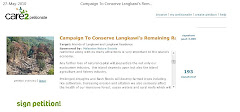On those pasar malam days, I observed that most littering on the ground left by the public mostly came from all those small to medium sized of red, green, yellow or white plastic bags. It is the "D-day" when a lot of NEW plastic bags and polystyrene boxes (Styrofoam) were utilised. I don't have the statistics or plastic usage count now but I am sure you can imagine this. Each time a different kind of food is purchased, a new plastic bag will be used. For example, a person walks to a stall that sells an assortment of delicacies. He will chose a few pieces of fried chicken and a NEW plastic bag is used. Then he picked up RM2 of keropok lekor (fried fish crackers) and second NEW plastic bag is used. Hmm... how about a pack of nasi lemak kukus? And a NEW Styrofoam box is used. The list goes on. Imagine he walks to the next store, he does the same thing and together with hundreds of other people doing the same thing too. That is hell of a lot of NEW plastic bags and Styrofoam boxes used in one night! The worse part of it is when some of these irresponsible people threw these NEW plastic bags and Styrofoam boxes onto the ground, into the nearby river, into the drain or even next to a tree after they had filled up their tummies. This is not an unusual sight in Langkawi for I had seen this many times and had seen enough of it!
Also, pasar malam is the spot where most of the Langkawi locals congregate and "lepak".

The green, red, yellow, white small or medium sized new plastic bags
Kak Zuraidah has knocked on doors of NGOs, government agencies and other stakeholders of Langkawi. She has been getting positive response from most of them. Bravo, Zue!!
And so, this event will happen on Wednesday, March 3oth in Kuah town where the pasar malam is happening. Here are the details:
Date: Wednesday, 30th March 2011
Time: 6:00pm-6:30pm
Meeting point: Tapak Ramadhan, Kuah Town
Our society has been dependent on plastics since an Englishman, Alexander Parkes invented the first human-made plastic in 1855. Surprisingly, polystyrene was discovered earlier than plastic, which was in 1835 by a German, Eduard Simon. Plastic is inevitable and it is impossible to create a plastic-less society within a short span of time. Not in my lifetime, at least.
Most of us would have known about the 3Rs (Recycle, Reuse and Reduce) and there is no need for introduction here. With the 3Rs, which "R" should come first? This is my personal opinion. The "R"s lining up with the utmost priority should be "Reduce"; follow by "Reuse" and then "Recycle".
With this pasar malam event, I hope this will create awareness to the locals that the first priority is to REDUCE usage of new plastic bags and polystyrene materials. By reducing, then REUSING is possible by bringing your old plastic bags or any reusable bags (eg cloth bag). Lastly, "RECYCLE" those existing plastic or glass materials once their usage are exhausted.
Bring any kind of containers. As long as new plastic bags or styrofoam boxes can be avoided
Kak Zuraidah's wishlist on this day will be having lots and lots of people participating together with a perfect weather. In order for this effort to be effective and impactful, this gathering ought to be done continuously, for example, once a month or even twice a month. An once off event tend to make a purpose to be forgotten; homosapiens' habit. Best of luck to you, Kak Zuraidah and thank you so much for making this happen.
As I mentioned earlier, this effort is the easiest task for the public to do and zero cost. As easy as All Bring Containers (ABC). Please spread the words/emails around for the benefit of making Langkawi a greener island to live. Keep these in your car; old reusable plastic bags, food containers or cloth bag or anything you can use to take-away your lunch/dinner. Remember, "Ingat Bungkus, Ingat Bekal".
Links:
1) Wikipedia about Plastic
2) Wikipedia about Alexander Parkes
3) The History of Polystrene































